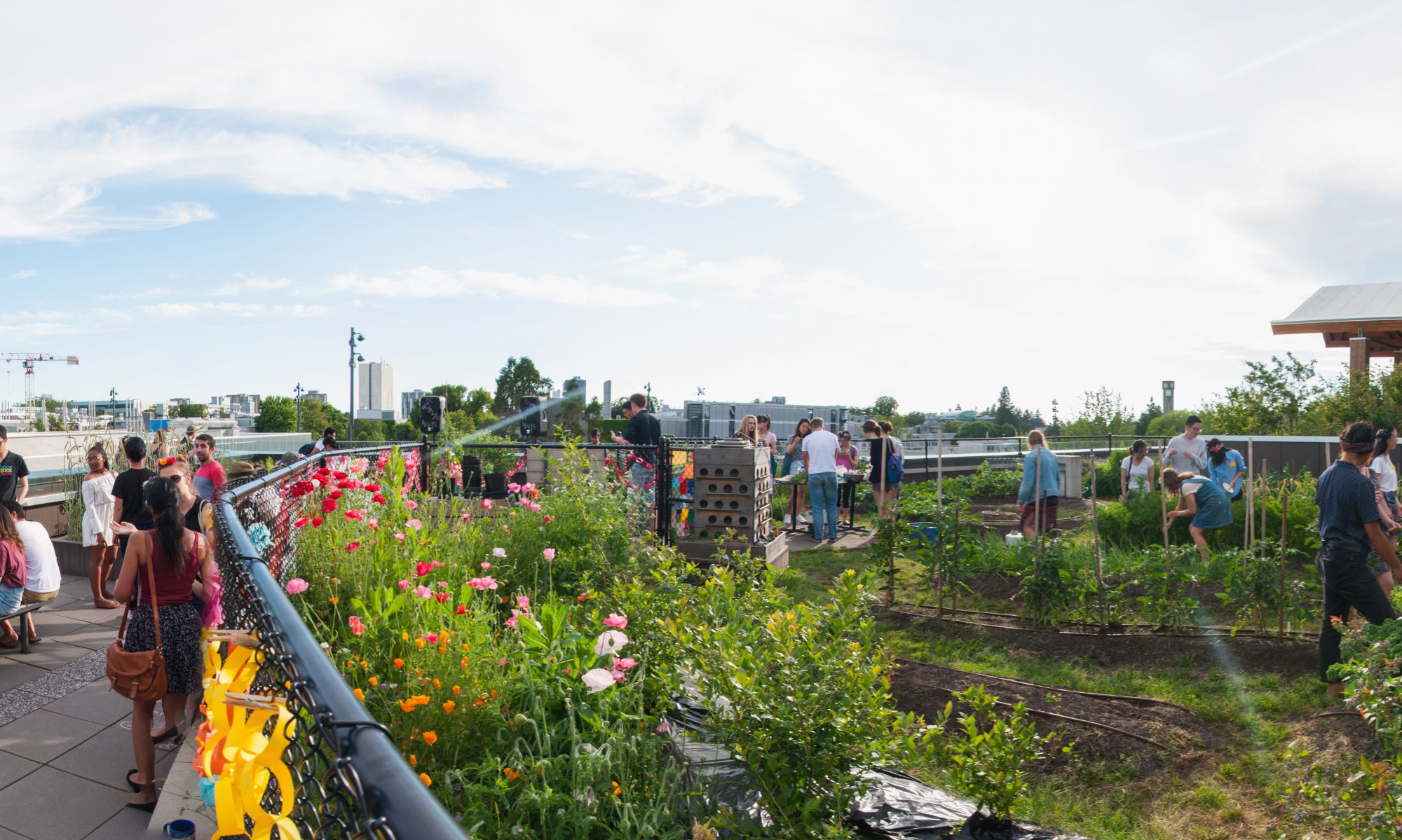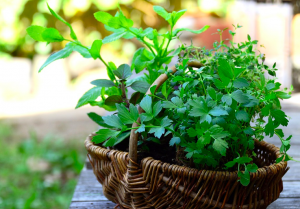Herbs are the most popular plants for beginners because they tend to be small and easy to harvest. A good herb garden will go a long way to elevate your cooking, while adding anti inflammatory compounds and antioxidants to your diet.
Basil
Basil is a warm season crop that will die in the winter unless you bring it indoors. Luckily it will grow very well in pots. Make sure you pick a sunny window sill though, because this plant likes full sun. Buy seedlings at the nursery, or start seeds indoors 6 weeks before the last spring frost. If you’re growing outdoors, wait until late spring or early summer when the soil warms to 21°C (70°F) before transplanting. Once your plant has 6 leaves, pinch it back to just above the second set of leaves. This will encourage the plant to grow branches and more leaves down the road. If flowers grow, cut them off. Tomatoes are a good companion plant to basil.
Parsley
For the best results, soak the seeds overnight before sowing 6mm (¼”) deep. Make sure the soil is around 21°C (70°F), whether you’re growing indoors or out, and allow 2 to 4 weeks for germination. Because the seeds are finicky, many gardeners find it easier to buy parsley seedlings from a nursery. Parsely needs sun but can easily tolerate some shade, and likes to kept moist.
Cilantro
Cilantro grows quickly, and will be ready for harvest in 3 to 4 weeks. If planting outside, consider working compost into the soil 46cm (18’’) deep prior to planting. Sow the seeds 6mm (¼”) deep and eventually thin them to 15 to 20cm (6-8’’) apart. For a continual fresh harvest, make successive plantings every 2 to 3 weeks. Cilantro is a cool season herb that prefers a 15°C (60°F) soil temperature for germination and suffers when temperatures rise above 21°C (70°F), so keep the thermostat down if growing indoors. Cilantro needs consistently moist soil and full sun.
Dill
Dill will grow quite tall, so it’s not the best indoor plant, but it can still be done. Sow seeds 6mm (¼”) deep and eventually remove the weakest sprout to thin the crop so that plants are 46cm (18’’) apart. Best germination results occur when soil is consistently moist and temperatures are between 15 and 21°C (60-70°F), and should take 10 to 14 days. Dill will easily self seed; If you let your plant go to seed at the end of the season, chances are new plants will grow on their own next spring. Dill grows well with cabbage and onions, but poorly with carrots.
Lemon balm
Lemon balm is a perennial, so once you plant it in your garden it’ll come back year after year. Sow the seeds by sprinkling them over the surface of the soil then barely cover them with dirt. Keep the seedbed moist and give 10 to 14 days for germination. Once the sprouts establish themselves, transplant them 45cm (18″) apart or to separate containers. Many gardeners prefer to grow lemon balm in containers because it is notorious for taking over the garden, but pinching off the flowers as they appear can help keep this aggressive grower in check. Lemon balm actually prefers partial shade to full sun, making it well adapted to indoor growing. However, it’s a cool season herb that grows best in temperatures between 10°C (50°F) and 21°C (70°F), so don’t heat your house too much. If growing outdoors remember to prune lemon balm down to just 5cm (2”) of stem in the fall once it dies back.
Mints
There are many kinds of mints to choose from, lemon balm actually being one of them. Mint is an aggressive perennial that is very easy to grow. In fact, most advice on growing mint is about how to stop it from growing and taking over your life! Buy baby mint plants from the nursery, or just snip a stem off an existing plant and place it in water until it grows roots and becomes a new plant, at which point you can stick it in the dirt. Mint also prefers partial shade and will repel mice, which makes it a popular indoor plant. For outdoor plants, cut them down to 2.5cm (1’’) from the ground at the end of the season right before they set flower.
Nasturtiums
The edible flower of the nasturtium has a sharp, spicy flavor and makes an attractive garnish to salads. The real reason they’re popular, however, is because their striking orange blooms do a great job of attracting pollinators to the garden. Many crops, including curcubits, nightshades, and berries require pollination from insects in order to produce. This sprawling plant has less utility for indoor gardens, but outdoors will thrive easily in partial shade with minimal care. Direct sow seeds 5mm – 1cm (¼”-½”) deep 1 week after the last spring frost giving generous space between plants. Nasturtiums are annuals, so they will need to be replanted each year.
Sage
Sage is a warm season perennial that grows easily in containers. Sow seeds 3mm (1/8″) deep, and keep soil lightly moist. At an optimal soil temperature of 15-21°C (60-70°F), seeds should sprout in 2 to 3 weeks. Once they are established, thin or transplant the sprouts to 45-60cm (18-24″) apart. Most gardeners prefer to buy young plants from a nursery or to propagate cuttings (cut off a branch of sage and place it in water until it grows roots) because plants started from seed will likely need several years to fully mature. Plant sage with rosemary, cabbage, and carrots, and remove the heavier, woody stems left behind from the previous year each spring. Do not plant sage near cucumbers.
Oregano
Oregano is another perennial that grows well in containers and indoors. Sprinkle the seeds over the soil, mist with water, and cover with plastic wrap to retain moisture. The seeds should sprout in about a week. For an even easier option, buy seedlings from the nursery or propagate from cuttings. Just make sure that soil temperatures are at 21°C (70°F) if transplanting outdoors. Oregano will keep the aphids off tomatoes when planted near by, and makes a wonderful companion plant to other vegetables as well. Regular harvesting benefits the plant by keeping it bushy as opposed to scraggly. Once established, oregano needs minimal care. It’s a drought resistant plant that won’t need to be watered unless the weather is excessively dry. For indoor plants, only water when the soil is dry to the touch.
Rosemary
Propagating cuttings is the easiest way to grow rosemary, but you can also buy seedlings or germinate seeds. In the spring, sow seeds 1cm (½‘’) and they will sprout in 14 to 21 days. Either start seeds indoors, or wait until the soil temperature rises to 27-32°C (80-90°F). Rosemary is a perennial in zones 6 to 10, but in colder zones will need to be brought indoors. Luckily, rosemary grows well indoors. Give rosemary plenty of light and water sparingly.
Tarragon
Unlike most plants, tarragon prefers dry, sandy, relatively low nutrient soil. Growing from seed is complicated, so buy nursery starts or propagate from cuttings instead. Give your plants full sun and remove any flowers as they appear to stimulate growth. Tarragon can be grown indoors or in containers, but when given the space will reach just under 1m (2-3’) in height. It should but cut back slightly before reaching this height, however, to keep it from falling over.
Thyme
Thyme loves heat and full sun and thrives in zones 5 to 9. Like rosemary, it likes dry conditions, so don’t over water. Seeds are slow to germinate and unreliable, so it’s easiest to buy seedlings or propagate from cuttings. Thyme will grow well in containers and indoors, and in the garden does well next to cabbage or tomatoes.


